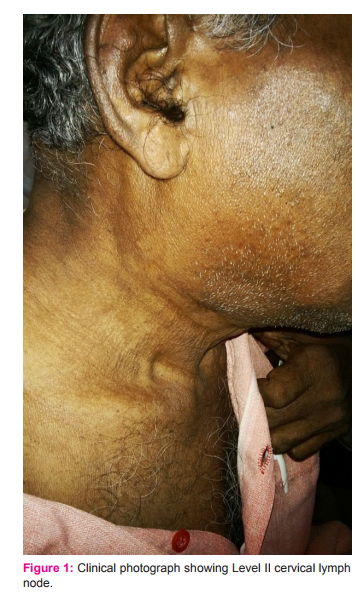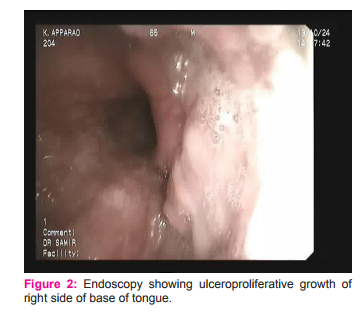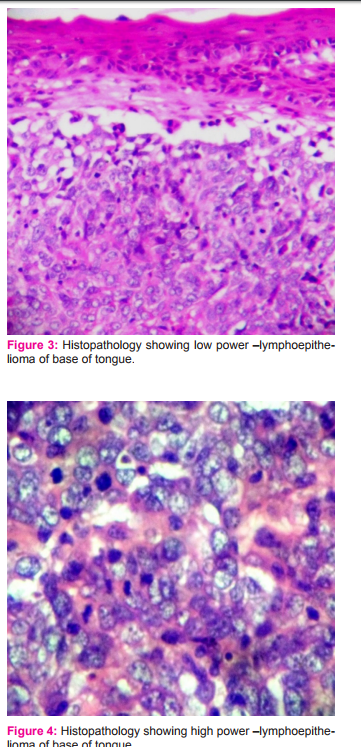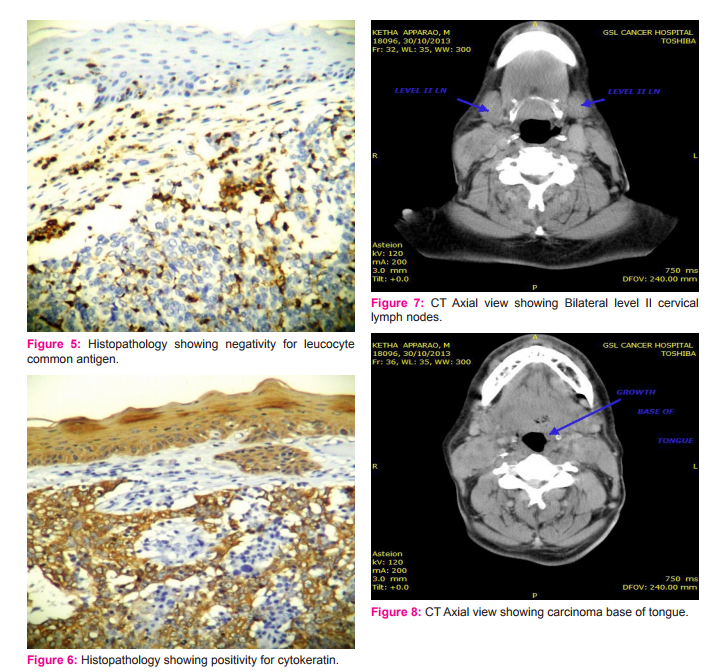IJCRR - 7(8), April, 2015
Pages: 67-70
Print Article
Download XML Download PDF
A RARE CASE OF LYMPHOEPITHELIOMA OF BASE OF TONGUE-NON NASOPHARYNGEAL LYMPHOEPITHELIOMA
Author: Surendra M., Siva Sankar Kotne, P. B. Ananda Rao, P. Ravindra Kumar
Category: Healthcare
Abstract:Background: Lymphoepithelioma (Squamous cell carcinoma with associated lymphoid stroma) commonly occurs in nasopharynx. It occurs rarely at other sites like oropharynx, laryngo-hypopharynx and salivary glands. Lymphoepitheliomas of base of tongue are less than 1% in head and neck region. Case Report: We present a rare case of 65years old male patient with lymphoepithelioma of base of tongue with bilateral cervical level II lymph nodes and immunohistochemistry showing positivity for cytokeratin and negativity for leucocyte common antigen. Patient is also a known Hansen's disease, which was treated 10 years back and has left lower limb amputated for chronic venous ulcer. Treatment Guidelines: Treatment course was planned as per stage with radical radiotherapy with concurrent chemotherapy. Wider volume (CTV) was given to cover distant regional spread as the tumour is locally aggressive. Conclusion: Lymphoepitheliomas are radiosensitive tumours with higher rates of locoregional tumour control, achieved with concomitant chemo radiotherapy in all head and neck sites.Distant metastasis was seen in patients with lymph node involvement and was a cause of poor prognosis. Non nasopharyngeal lymphoepithelioma can be planned better than nasopharyngeal tumours as in the later, organs at risk are near by.
Keywords: Lymphoepithelioma, Hansen’s disease, CTV (clinical tumour volume)
Full Text:
INTRODUCTION
Head and neck cancer is one of the most common cancers world wide accounting for5 to10%, more than 90% tumours are squamous cell carcinomas. Lymphoepithelioma (squamous cell carcinoma associated lymphoid stroma) occurs primarily in the nasopharynx ,rare in other sites such as upper aerodigestive tract including the major salivary glands1 , oral cavity2 , oropharynx ,larynx3 , hypopharynx, etc. Lymphoepithelioma5 is an undifferentiated carcinoma with a prominent reactive lymphoplasmocytic infiltrate morphologically indistinguishable from nasopharyngeal carcinoma. Microscopically lymphoepithelioma shows a rather prominent squamous cell carcinoma component in about half of the cases and sometimes lymphoepithelioma exhibit such a dense lymphoplasmocytic infiltrate that it mimics malignant lymphoma. Lymphoepithelioma are aggressive tumours with a propensity for regional lymphnode and distant metastases.
CASE REPORT
We present a rare case of 65 year old male patient who came with bilateral level II cervical lymphnode swelling and odynophagia. Videolaryngeo scopy showed an ulceroproliferative growth over base of tongue on the left side. Biopsy was taken and it showed features of lymphoepithelioma/ undifferentiated nasopharyngeal carcinoma of base of tongue. Upper gastrointestinal endoscopy shows growth base of tongue and impaired mobility of right vocal cord. Patient had history of Hansen’s disease 40 years back which then treated. Patient had right lower limb below knee amputation for chronic venous ulcer 15 years back. Regular systemic examination was normal. Immunohistochemistry revealed the tumour to be positive for cytokeratin and negative for leucocyte common antigen excluding lymphoma. Ultrasonography abdomen is normal. CT scan of head and neck showed growth of tongue and level II cervical LN.
TREATMENT GUIDELINES
Treatment was planned with definitive chemoradiotherapy. Patient was immobilized in a thermoplastic mask in supine position. Radical RT of 6600cGy in 33fractions and five fractions per week and 200cGy per fraction was delivered to wider volume (CTV) to cover the primary site and lymphnodal area as the tumour is locally aggressive with a chance of distant metastasis . Spinal cord was spared after 44Gy. 5 cycles of cisplatin based chemotherapy were given for radiosensitization for tumour kill.
DISCUSSION
Lymphoepithelioma is a clinicopathologic entity that was described simultaneously but independently by Schminke and Regaud in 1921. In 1929, Ewing concurred that LE should be considered a separate category of nasopharyngeal carcinoma; he noted that the distinguishing feature of these tumors was their radiosensitivity. It has been firmly established that the lymphocytes in the lymphoid stroma are neither neoplastic nor integral to the carcinomatous process. In 1978, the World Health Organization published a histologic typing system for nasopharyngeal carcinoma based on the appearance of the malignant epithelial cells. In this system, all three categories of nasopharyngeal tumors can be associated with a lymphoid stroma. Oropharyngeal LE is a rare disease. Between 1960 and 1983, only 13 cases of oropharyngeal LE were seen at the Mayo Clinic. At the Institut Gustave-Roussy, 18 patients were treated who had undifferentiated carcinoma of the nasopharyngeal type (UCNT) located in the tonsillar fossa; these 18 cases were identified in a retrospective pathologic review of 2262 patients with carcinoma of the tonsillar region. The report does not state whether a lymphoid stroma was present in these cases. Twenty-four of the 34 patients in the report had oropharyngeal LE. Outside of Waldeyer’s tonsillar ring, mucosal nonnasopharyngeal LE is even rarer. At the Mayo Clinic, 4 cases of laryngohypopharyngeal LE were seen between 1907 and 1984. Micheau et al. identified 3 cases of laryngeal LE in a review of 2430 laryngectomy and pharyngectomy specimens. Ferlito reviewed the pathologic specimens of 2052 laryngohypopharyngeal neoplasms and found only 1 case of LE of the hypopharynx. Patients with nonnasopharyngeal LE have a high incidence of lymph node metastasis and a propensity for distant metastasis. Our locoregional treatment strategy for patients with nonnasopharyngeal LE will be to irradiate all the primary tumors.
CONCLUSION
Nasopharyngeal lymphoepithelioma of base of tongue is a rare entity with good response to treatment. Here we are reportin g a case with cured Hansen’s disease also. Now the patient is in follow up and doing well.




References:
1. Zbaren P, Borisch B, Lang H, Greiner R. Undifferentiated carcinoma of nasopharyngeal type of the laryngopharyngeal region. Otolaryngol Head Neck Surg 1997: 117: 688– 693.
2. Chow1, Chow, Lui, Sze, Yuen, Kwok; Lymphoepitheliomalike carcinoma of oral cavity: Report of three cases and literature review; Int. J. Oral Maxillofac. Surg. 2002.
3. Merz H, Marnitz S, Erbersdobler A, Goektas O. Schminckes tumour, Carcinoma of the base of the tongue, a case report. Case rep oncol. 2010;3(1):77–82
4. Klijanienko J, Micheau C, Azli N, et al. Undifferentiated carcinoma of nasopharyngeal type of tonsil. Arch Otolaryngol Head Neck Surgery 1989: 115: 731–734.
5. SUN Xiao-nan, XU Jing, YANG Qi-chu, HU Jian-bin and WANG Qi; Lymphoepithelioma-like carcinoma of the submandibular salivary gland: a case report; Chinese Medical Journal 2006. 119(15):1315–1317.
6. Dubey P, Ha CS, Ang KK, et al. Nonnasopharyngeal lymphoepithelioma of the head and neck. Cancer 1998: 82: 1556–1562.
|






 This work is licensed under a Creative Commons Attribution-NonCommercial 4.0 International License
This work is licensed under a Creative Commons Attribution-NonCommercial 4.0 International License